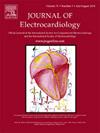急性非ST段抬高型心肌梗死患者心电图得出的 T 波振幅和 T/R 比值与 Syntax 评分之间的关系
IF 1.2
4区 医学
Q3 CARDIAC & CARDIOVASCULAR SYSTEMS
引用次数: 0
摘要
目的和背景我们的目的是确定急性非 ST 段抬高型心肌梗死(ANSTEMI)患者 T 波振幅(TWA)和 T/R 比值(定义为 T 波和 R 波之间的振幅比值)偏低的诊断意义。语法评分(SS)显示冠状动脉疾病的扩展情况。方法回顾性纳入了 2021 年 7 月至 2022 年 12 月期间的 266 例 ANSTEMI 患者。根据患者的血管造影和临床数据计算出 SS-1 和 SS-2 评分。根据中位 SS-1 评分将患者分为低、中、高 SS-1 三等分。以数字方式测量心电图参数,包括 II 和 V5 导联的 TWA 和 T/R 比值。结果TWA和T/R比值在导联II和V5中明显低于SS-1三等分(导联II中的TWA为0.001)(导联II中的T/R比值为0.001)(导联V5中的TWA为0.014)(导联V5中的T/R比值为0.002)。结论 T/R比值较低,尤其是在导联II中,因为其AUC较大,能更好地预测ANSTEMI患者的中度至高度SS-1。本文章由计算机程序翻译,如有差异,请以英文原文为准。
Relationship between ECG-derived T-wave amplitude and T/R ratio and Syntax score in patients with acute non-st segment elevation myocardial infarction
Objectives and background
Our objective was to determine the diagnostic significance of a low T-wave amplitude (TWA) and T/R ratio, defined as the amplitude ratio between the T waves and the R waves, in patients with acute non-ST elevation myocardial infarction (ANSTEMI). Syntax score (SS) shows the extension of coronary artery disease. Previously, low TWA and T/R ratios were demonstrated to be inversely proportional to the risk of sudden cardiac arrest in different cardiac disease conditions.
Methods
266 patients were retrospectively included with ANSTEMI between July 2021 and December 2022. SS-1 and SS-2 scores were calculated using the angiographic and clinical data of the patients. The patients were stratified into tertiles based on their median SS-1 scores as lower, moderate, and higher SS-1 tertiles. ECG parameters, including TWAs and T/R ratios in leads II and V5, were measured digitally. TWA and T/R ratios were compared with SSs among the tertiles.
Results
TWA and T/R ratios in leads II and V5 were significantly lower across the increasing SS-1 tertiles (p < 0.001 for TWA in lead II) (p < 0.001 for T/R ratio in lead II) (p = 0.014 for TWA in lead V5) (p = 0.002 for T/R ratio in lead V5).ROC analysis identified T/R ratios in leads II and V5 of 0.254 (AUC: 0.758, p < 0.001) and 0.201 (AUC: 0.635, p < 0.015), respectively.
Conclusion
A low T/R ratio, particularly in lead II due to its greater AUC, better predicts moderate-to-high SS-1 in patients with ANSTEMI.
求助全文
通过发布文献求助,成功后即可免费获取论文全文。
去求助
来源期刊

Journal of electrocardiology
医学-心血管系统
CiteScore
2.70
自引率
7.70%
发文量
152
审稿时长
38 days
期刊介绍:
The Journal of Electrocardiology is devoted exclusively to clinical and experimental studies of the electrical activities of the heart. It seeks to contribute significantly to the accuracy of diagnosis and prognosis and the effective treatment, prevention, or delay of heart disease. Editorial contents include electrocardiography, vectorcardiography, arrhythmias, membrane action potential, cardiac pacing, monitoring defibrillation, instrumentation, drug effects, and computer applications.
 求助内容:
求助内容: 应助结果提醒方式:
应助结果提醒方式:


